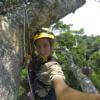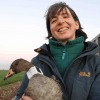With new technologies revolutionizing data collection, wildlife researchers are becoming increasingly able to collect data at much higher volumes than ever before. Now we are facing the challenges of putting this information to use, bringing the science of big data into the conservation arena. With the help of machine learning tools, this area holds immense potential for conservation practices. The applications range from online trafficking alerts to species-specific early warning systems to efficient movement and biodiversity monitoring and beyond.
However, the process of building effective machine learning tools depends upon large amounts of standardized training data, and conservationists currently lack an established system for standardization. How to best develop such a system and incentivize data sharing are questions at the forefront of this work. There are currently multiple AI-based conservation initiatives, including Wildlife Insights and WildBook, that are pioneering applications on this front.
This group is the perfect place to ask all your AI-related questions, no matter your skill level or previous familiarity! You'll find resources, meet other members with similar questions and experts who can answer them, and engage in exciting collaborative opportunities together.
Just getting started with AI in conservation? Check out our introduction tutorial, How Do I Train My First Machine Learning Model? with Daniel Situnayake, and our Virtual Meetup on Big Data. If you're coming from the more technical side of AI/ML, Sara Beery runs an AI for Conservation slack channel that might be of interest. Message her for an invite.
Header Image: Dr Claire Burke / @CBurkeSci

Explore the Basics: AI
Understanding the possibilities for incorporating new technology into your work can feel overwhelming. With so many tools available, so many resources to keep up with, and so many innovative projects happening around the world and in our community, it's easy to lose sight of how and why these new technologies matter, and how they can be practically applied to your projects.
Machine learning has huge potential in conservation tech, and its applications are growing every day! But the tradeoff of that potential is a big learning curve - or so it seems to those starting out with this powerful tool!
To help you explore the potential of AI (and prepare for some of our upcoming AI-themed events!), we've compiled simple, key resources, conversations, and videos to highlight the possibilities:
Three Resources for Beginners:
- Everything I know about Machine Learning and Camera Traps, Dan Morris | Resource library, camera traps, machine learning
- Using Computer Vision to Protect Endangered Species, Kasim Rafiq | Machine learning, data analysis, big cats
- Resource: WildID | WildID
Three Forum Threads for Beginners:
- I made an open-source tool to help you sort camera trap images | Petar Gyurov, Camera Traps
- Batch / Automated Cloud Processing | Chris Nicolas, Acoustic Monitoring
- Looking for help with camera trapping for Jaguars: Software for species ID and database building | Carmina Gutierrez, AI for Conservation
Three Tutorials for Beginners:
- How do I get started using machine learning for my camera traps? | Sara Beery, Tech Tutors
- How do I train my first machine learning model? | Daniel Situnayake, Tech Tutors
- Big Data in Conservation | Dave Thau, Dan Morris, Sarah Davidson, Virtual Meetups
Want to know more about AI, or have your specific machine learning questions answered by experts in the WILDLABS community? Make sure you join the conversation in our AI for Conservation group!
No showcases have been added to this group yet.
- 0 Resources
- 0 Discussions
- 16 Groups
- 0 Resources
- 0 Discussions
- 5 Groups
- @sruizguz
- | He / Him / His
Laboratory research technician at the Kitzes lab - University of Pittsburgh. My research focuses on acoustic monitoring for ecology and conservation.
- 0 Resources
- 0 Discussions
- 4 Groups
- @jenlaw
- | She/Her
Biodiversity scientist specialising specialising in the study of tropical ecosystems and their biodiversity using multiple forms of technology, including acoustics, images and robotics.
- 0 Resources
- 0 Discussions
- 14 Groups
World Wide Fund for Nature/ World Wildlife Fund (WWF)
- 0 Resources
- 7 Discussions
- 12 Groups
The University of Queensland
Passionate about using technology and data to solve conservation issues.
- 0 Resources
- 2 Discussions
- 9 Groups
- @ldbraunholtz
- | she/her
(Tropical) forest ecologist w interest: biodiversity, camera traps, community led conservation & more. Passionate about inclusive nature for all.
- 0 Resources
- 0 Discussions
- 10 Groups
- @Riley
- | she/they
I'm a Data Scientist at Western EcoSystems Technology. I am interested in AI processing and statistical modeling of acoustic data and camera trap and drone imagery.
- 3 Resources
- 5 Discussions
- 5 Groups
- @jscanass
- | he/him
University College London (UCL) & Red Ecoacústica Colombiana
PhD Student at UCL
- 0 Resources
- 1 Discussions
- 8 Groups

- 9 Resources
- 0 Discussions
- 4 Groups
- 0 Resources
- 0 Discussions
- 2 Groups
- @Gathoni
- | Her/she
PhD Candidate at Nottingham Trent University, UK. Ecologist with a passion for wildlife conservation and conservation technology with foundational training in BSc and MSc Rangeland Management (Ecology option). Current project: Use of acoustics to monitor ecosystem restoration.

- 5 Resources
- 8 Discussions
- 8 Groups
Come and do the first research into responsible AI for biodiversity monitoring, developing ways to ensure these AIs are safe, unbiased and accountable.
11 June 2024
€4,000 travel grants are available for researchers interested in insect monitoring using automated cameras and computer vision
6 June 2024
WildLabs will soon launch a 'Funding and Finance' group. What would be your wish list for such a group? Would you be interested in co-managing or otherwise helping out?
5 June 2024
Now accepting applications for two $15,000 grants to help protect wildlife through cutting-edge, technology-driven efforts
3 June 2024
These authors "develop an approach based on stochastic simulations of biodiversity and a deep learning model to infer richness at global or regional scales through time while incorporating spatial, temporal and...
20 May 2024
Check out this paper that reviews the current state of AI in conservation.
9 May 2024
In 1987, sustainability was defined by the United Nations Brundtland Commission as “meeting the needs of the present without compromising the ability of future generations to meet their own needs.”In 1987,...
7 May 2024
€2,000 travel grants are available for researchers interested in insect monitoring using automated cameras and computer vision
3 May 2024
Save the Elephants is seeking a Principal Investigator for our Elephant Collective Behaviour Project. This role will spearhead research initiatives using cutting-edge video analysis tools to study elephant group...
1 May 2024
Article
Read in detail about how to use The Inventory, our new living directory of conservation technology tools, organisations, and R&D projects.
1 May 2024
Article
The Inventory is your one-stop shop for conservation technology tools, organisations, and R&D projects. Start contributing to it now!
1 May 2024
Technology to End the Sixth Mass Extinction. Salary: $132 - $160k; Location: Seattle WA; 7+ years of experience in hardware product development and manufacturing; View post for full job description
1 May 2024
August 2025
event
September 2025
event
event
event
event
October 2025
event
event
event
December 2025
event
March 2026
June 2023
event
May 2023
event
17 Products
Recently updated products
| Description | Activity | Replies | Groups | Updated |
|---|---|---|---|---|
| Hi Wildlabbers, We're getting ready for tomorrow's episode with Tech Tutor Lily Xu, who'll talk to us about how machine... |
|
AI for Conservation, Protected Area Management Tools, Wildlife Crime | 3 years 11 months ago | |
| Looks good, but what is the added value compared to other examples as Obsidentify and Plantnet? |
+13
|
AI for Conservation | 3 years 11 months ago | |
| https://www.dryad.netJob description"Dryad is an environmental IoT startup based in Berlin-Brandenburg. Our mission is to develop a large-... |
|
AI for Conservation | 3 years 11 months ago | |
| Deep Learning Engineer at Pachama - https://jobs.lever.co/pachama/81716dd9-8019-4916-add2-fcfaae426331 Embedded Software Engineer... |
|
AI for Conservation | 3 years 11 months ago | |
| Hi everyone, We're excited to welcome Nicole Flores to Tech Tutors to walk us through getting started with Wildlife Insights! ... |
|
AI for Conservation, Camera Traps, Data management and processing tools | 4 years ago | |
| Hi all, We're excited to welcome Siyu Yang to Tech Tutors to chat about getting started with Megadetector! For all you AI... |
|
AI for Conservation, Camera Traps, Data management and processing tools | 4 years ago | |
| You should join the Key Conservation app, which connects people and NGO's for specific needs, whether funding, time, or skills (programming included). Organizations can list... |
|
AI for Conservation | 4 years 2 months ago | |
| Thank you VERY much for that, Carly. I really appreciate it. I have only heard of the bear research project and was not aware of the others. This is very helpful. FYI: Most... |
|
AI for Conservation | 4 years 4 months ago | |
| The Atlas Coral Atlas combines high-resolution, seamless satellite imagery mosiacs, image processing techniques, machine learning, and... |
|
AI for Conservation | 4 years 5 months ago | |
| Sure thing, I'll email you directly. |
|
AI for Conservation | 4 years 5 months ago | |
| Hi Wildlabbers, This week is the last episode of Tech Tutors Season 2! Elizabeth Bondi tackled the question "How do I... |
|
AI for Conservation, Drones | 4 years 6 months ago | |
| Thanks Carly, These are great ideas. The movebank recommendation reminds me of some work from Save the Elephants that used its transparency to exonerate an elephant that had... |
|
AI for Conservation | 4 years 6 months ago |



































